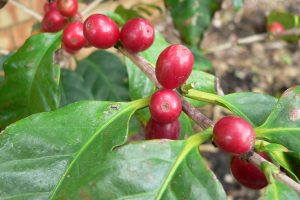Coffea arabica, C. canephora, C. liberica
Coffee, arabica, robusta
Origin
There are 125 coffee species, which occur naturally in Africa, the Indian Ocean Islands, southern Asia and Australia. Coffea arabica, the most commonly used species, is native to northeast Tropical Africa and possibly East Tropical Africa. Coffea canephora, synonym Coffea robusta, has its origins in central and western sub-Saharan Africa. Coffea liberica is a bigger tree with larger cherries, flowering only when days are 13hrs or shorter; they are very popular in Malaysia but represent only 1% of world trade.
Climate
Sub-tropical and high-elevation tropical. Humid, evergreen forest.
Plant Description
Coffea arabica is a small tree, 2 to 8m tall, with characteristic horizontal branching, although in plantations it is usually pruned to take the form of a small shrub. Its leaves are evergreen and usually shiny. It is potentially very-long lived, with trees 100 years old still producing.
Relatives
Rubiaceae Family. Relatives include the little-known genipap and noni.
Soils
Coffee thrives best on deep, rich, acid soils. The plant has a strong thick tap root and a good system of radiating surface roots for feeding.
Propagation
Coffee is grown from seed. Remove the thin, papery skin (parchment) from the seed before planting.
Cultivars
There are many cultivars: Bourbon and Typica are some of the best known. There are dwarf forms and also many hybrids, such as Mundo Novo. The genome of C arabica, an allotetraploid formed as a result of natural hybridisation between C canephora & C eugenioides, has now essentially been sequenced & this should provide great assistance to breeding of superior cvs in the future.
Flowering and Pollination
The sweet-scented flowers of C. arabica are hermaphrodite with a white tubular corolla, normally 5-lobed.
Cultivation
Mulching, manuring and moisture are essential for good yield. Water stressing and then heavy irrigation is used to control flowering and fruit ripening. Slight shade is beneficial.
Wind Tolerance
Good.
Pruning
Seedlings should be topped from 1.2m back to 0.6m to create a spreading bush. Pruning weaker branches is done after harvest and the bush kept to about 2m for easy harvest. Fruit is only produced on new growth.
The Fruit
The fruit is a 2-seeded drupe, commonly called the cherry. Technically a stone fruit, the seeds are the coffee “beans”. If you squeeze open the coffee fruit you will find 2 slippery seeds with very little surrounding flesh. The fruits are usually red but sometimes yellow or purple at maturity. The pulp is soft, edible and sweet-tasting.
The seeds are pale fawn or brown (dark brown only after roasting) and have a characteristic groove on the inner surface, which curls round inside the seed. Arabica coffee is a hybrid species, formed by the hybridization of Coffea eugenioides and C. canephora. It is one of the only species in the genus that is autogamous, a single plant being able to produce fertile seed from its own pollen.
Fruit Production and Harvesting
Coffee cherries are picked when they ripen to a bright deep red colour, although there are a few cultivars which ripen to a deep yellow colour. Only pick ripe cherries. They do not all ripen at the same time, so several pickings are necessary. It is important to remove the seeds within 8 hours.
Fruit Uses
To process beans, squeeze the seeds from the cherries. They are then fermented in water for 12-18 hours (sometimes more, depending on the temperature), then dried in the sun for three weeks or in a dryer for about three hours. The parchment, or silver skin can either be rubbed off or left on. The beans are then oven-baked to a light or dark brown colour, according to taste. Coffee from robusta is more bitter than arabica but cheaper to produce, so it is usually used in blends with the latter.
Pests and Diseases
Coffee leaf disease appears to be the only problem and affects only the arabica varieties. This is the reason arabica is grown at high altitudes. Robusta is resistant to the disease, and is usually grown in the lowlands. Green coffee scale and mealy bug can be pests
Comments
Cultivated arabica is under threat because of a low-level of genetic diversity within the crop cultivars, leaving plantations vulnerable to pests, diseases and climate change. These problems are compounded for both wild populations and crops because coffee seeds cannot yet be stored successfully in conventional seed banks (in low temperature, low moisture environments).
